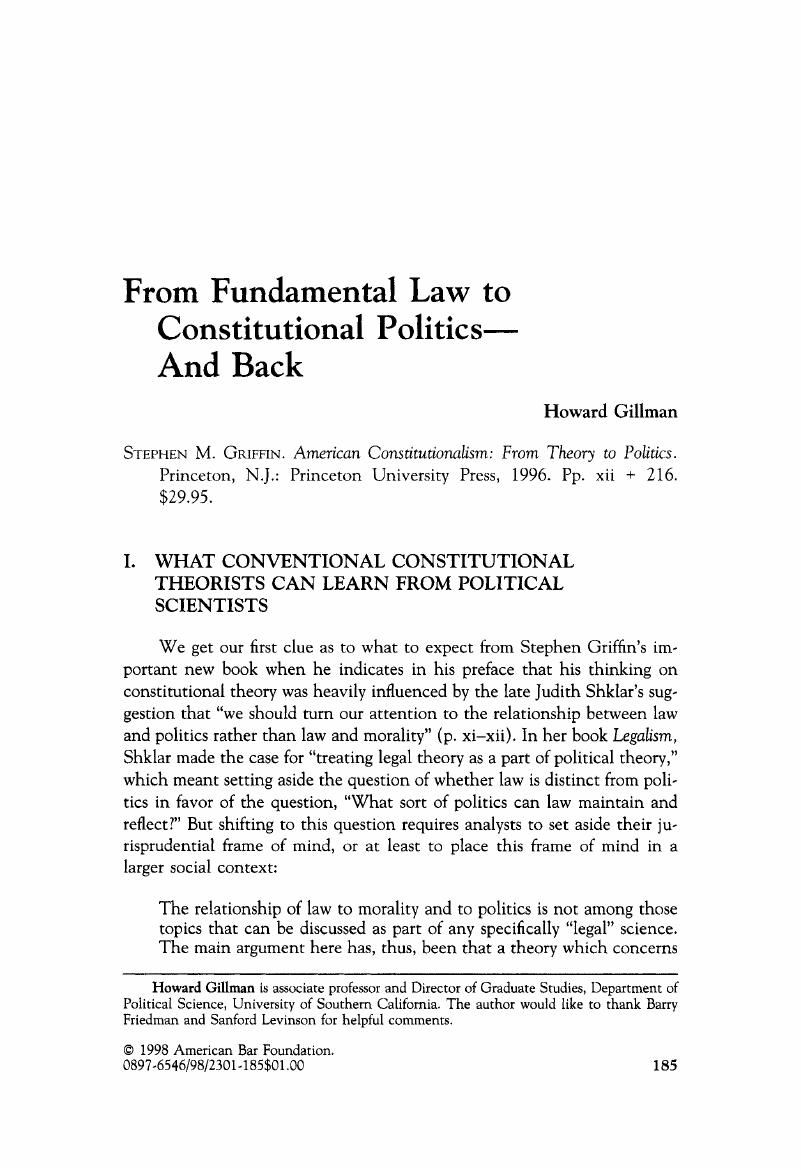No CrossRef data available.
Article contents
From Fundamental Law to Constitutional Politics– And Back
Published online by Cambridge University Press: 27 December 2018
Abstract
An abstract is not available for this content so a preview has been provided. Please use the Get access link above for information on how to access this content.

- Type
- Review Essay
- Information
- Copyright
- Copyright © American Bar Foundation, 1998
References
Ackerman, Bruce. 1991. We, the People: Foundations. Cambridge: Harvard University Press, Belknap Press.Google Scholar
Adamany, David. 1973. Legitimacy, Realigning Elections, and the Supreme Court. Wisconsin Law Review
1973:790–846.Google Scholar
Amar, Akhil Reed. 1994. The Consent of the Governed: Constitutional Amendment Outside Article V. Columbia Law Review
94:457–508.Google Scholar
Brigham, John. 1996. The Constitution of Interests: Beyond the Politics of Rights. New York: New York University Press.Google Scholar
Burgess, Susan R.
1992. Contest for Constitutional Authority: The Abortion and War Power Debates. Lawrence: University Press of Kansas.Google Scholar
Burt, Robert A.
1992. The Constitution in Conflict. Cambridge: Harvard University Press.Google Scholar
Casper, Jonathan D.
1976. The Supreme Court and National Policymaking. American Political Science Review
70:50–63.Google Scholar
Cover, Robert M.
1983. The Supreme Court 1982 Term–Foreword: Nomos and Narrative. Harvard Law Review
97:4–68.Google Scholar
Dahl, Robert. 1957. Decision-Making in a Democracy: The Supreme Court as a National Policymaker. Journal of Public Law
6:279–95.Google Scholar
Eskridge, William N. Jr.
1991a. Overriding Supreme Court Statutory Interpretation Decisions. Yale Law Journal
101:331–417.Google Scholar
Eskridge, William N. Jr.
1991b. Reneging on History? Playing the Court/Congress/President Civil Rights Game. California Law Review
79:613–84.Google Scholar
Fisher, Louis. 1988. Constitutional Dialogues: Interpretation as Political Process. Princeton, N.J.: Princeton University Press.Google Scholar
Fisher, Louis, and Devins, Neal. 1992. Political Dynamics of Constitutional Law. St. Paul, Minn.: West.Google Scholar
Gates, John. 1992. The Supreme Court and Partisan Realignment: A Macro- and Micro-level Perspective. Boulder, Colo.: Westview.Google Scholar
Gillman, Howard. 1993. The Constitution Besieged: The Rise and Demise of Lochner Era Police Powers Jurisprudence. Durham, N.C.: Duke University Press.Google Scholar
Gillman, Howard. 1994. Preferred Freedoms: The Progressive Expansion of State Power and the Rise of Modern Civil Liberties Jurisprudence. Political Research Quarterly
47:623–53.Google Scholar
Gillman, Howard. 1997. The Collapse of Constitutional Originalism and the Rise of the Notion of the “Living Constitution” in the Course of American State-Building. Studies in American Political Development
11:191–247.Google Scholar
Goldstein, Leslie Friedman. 1997. State Resistance to Authority in Federal Unions: The Early United States (1790–1860) and the European Community (1958–1994). Studies in American Political Development
11:149–89.Google Scholar
Graber, Mark. 1993. The Non-Majoritarian Difficulty: Legislative Deference to the Judiciary. Studies in American Political Development
7:35–73.Google Scholar
Graber, Mark. 1995. The Passive-Aggressive Virtues: Cohens v. Virginia and the Problematic Establishment of Judicial Power. Constitutional Commentary
12:67–92.Google Scholar
Harris, William F. II
1993. The Interpretable Constitution. Baltimore, Md.: Johns Hopkins University Press.Google Scholar
Horowitz, Morton J.
1993. Foreword: The Constitution of Change: Legal Fundamentality without Fundamentalism. Harvard Law Review
107:30–117.Google Scholar
Jacobsohn, Gary J.
1993. Apple of Gold: Constitutionalism in Israel and the United States. Princeton, N.J.: Princeton University Press.Google Scholar
Kalman, Laura. 1996. The Strange Career of Legal Liberalism. New Haven, Conn.: Yale University Press.Google Scholar
Klarman, Michael J.
1994. Has Brown Changed Race Relations? The Backlash Thesis. Journal of American History
81:81–118.Google Scholar
Knight, Jack, and Epstein, Lee. 1996. On the Struggle for Judicial Supremacy. Law & Society Review
30:237–120.Google Scholar
Kyvig, David E.
1996. Explicit and Authentic Acts: Amending the U.S. Constitution, 17761995. Lawrence: University Press of Kansas.Google Scholar
Lessig, Lawrence. 1995. Understanding Changed Readings: Fidelity and Theory. Stanford Law Review
47:395–472.Google Scholar
Levinson, Sanford, ed. 1995. Responding to Imperfection: The Theory and Practice of Constitutional Amendment. Princeton, N.J.: Princeton University Press.Google Scholar
Lowi, Theodore J.
1985. The Personal President: Power Invested, Promise Unfulfilled. Ithaca, N.Y. and London: Cornell University Press.Google Scholar
McCloskey, Robert G.
1960. The American Supreme Court. Chicago: University of Chicago Press.Google Scholar
McCloskey, Robert G.
1994. The American Supreme Court. 2d ed., rev. Sanford Levinson. Chicago: University of Chicago Press.Google Scholar
Moore, Wayne D.
1996. constitutional Rights and the Powers of the People. Princeton, N.J.: Princeton University Press.Google Scholar
Munzer, Stephen R., and Nickel, James W.. 1977. Does the Constitution Mean What It Always Meant
Columbia Law Review
77:1029–62.Google Scholar
Orren, Karen. 1991. Belated Feudalism: Labor, the Law, and Liberal Development in the United States. New York: Cambridge University Press.Google Scholar
Orren, Karen. 1995. The Primacy of Labor in American Constitutional Development. American Political Science Review
89:377–88.Google Scholar
Segal, Jeffrey A., and Spaeth, Harold J.. 1993. The Supreme Court and the Attitudinal Model. New York: Cambridge University Press.Google Scholar
Seidman, Louis Michael, and Tushnet, Mark V.. 1996. Remnants of Belief: Contemporary Constitutional Issues. New York: Oxford University Press.Google Scholar
Shapiro, Martin. 1964. Law and Politics in the Supreme Court: New Approaches to Political Jurisprudence. New York: Free Press.Google Scholar
Shapiro, Martin. 1984. Recent Developments in Political Jurisprudence. Western Political Quarterly
36:541–48.Google Scholar
Shklar, Judith N.
1986. Legalism: Law, Morals, and Political Trials. 1964. Reprint, Cambridge: Harvard University Press.Google Scholar
Skowronek, Stephen. 1982. Building a New American State: The Expansion of National Administrative Capacities, 1877–1920. New York: Cambridge University Press.Google Scholar
Smith, Rogers M.
1985. Liberalism and American Constitutional Law. Cambridge: Harvard University Press.Google Scholar
Smith, Rogers M.
1988. Political Jurisprudence, the “New Institutionalism,” and the Future of Public Law. American Political Science Review
82:239–108.Google Scholar
Stumpf, Harry. 1965. Congressional Response to Supreme Court Rulings: The Interaction of Law and Politics. Journal of Public Law
14:377–95.Google Scholar
Sunstein, Cass R.
1993. The Partial Constitution. Cambridge: Harvard University Press.Google Scholar
Whittington, Keith E.
1996. The Political Constitution of Federalism in Antebellum America: The Nullification Debate as an Illustration of Informal Mechanisms of Constitutional Change. Publius
26:1–24.Google Scholar


